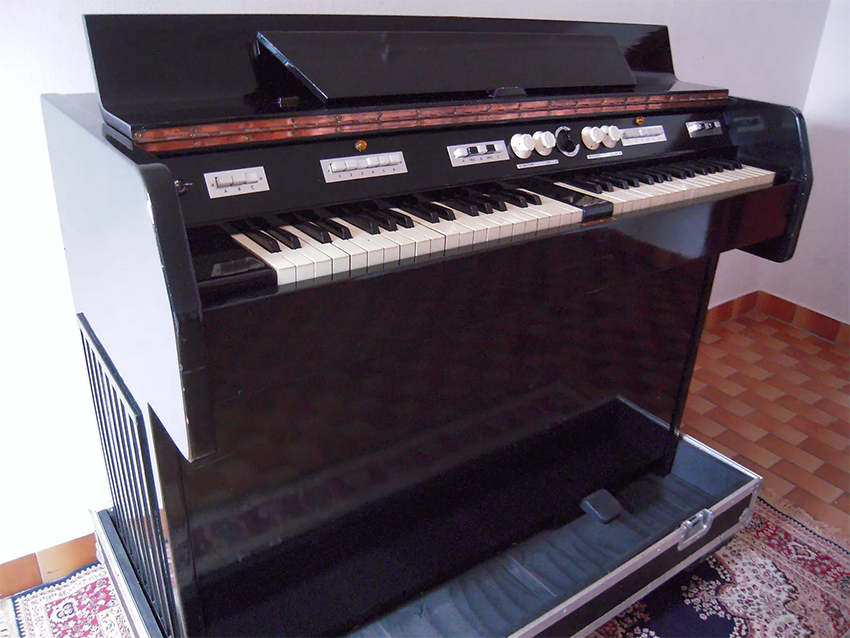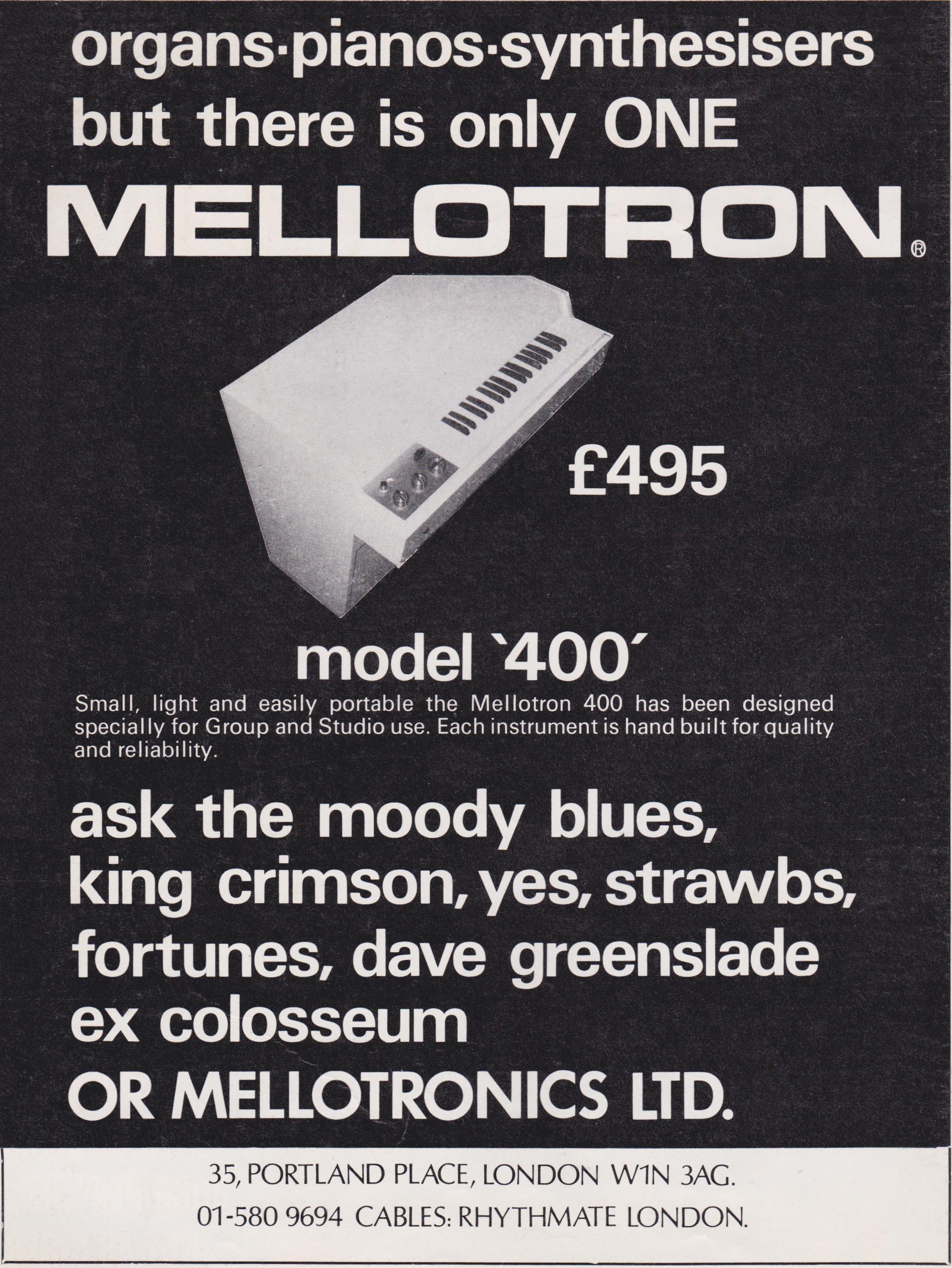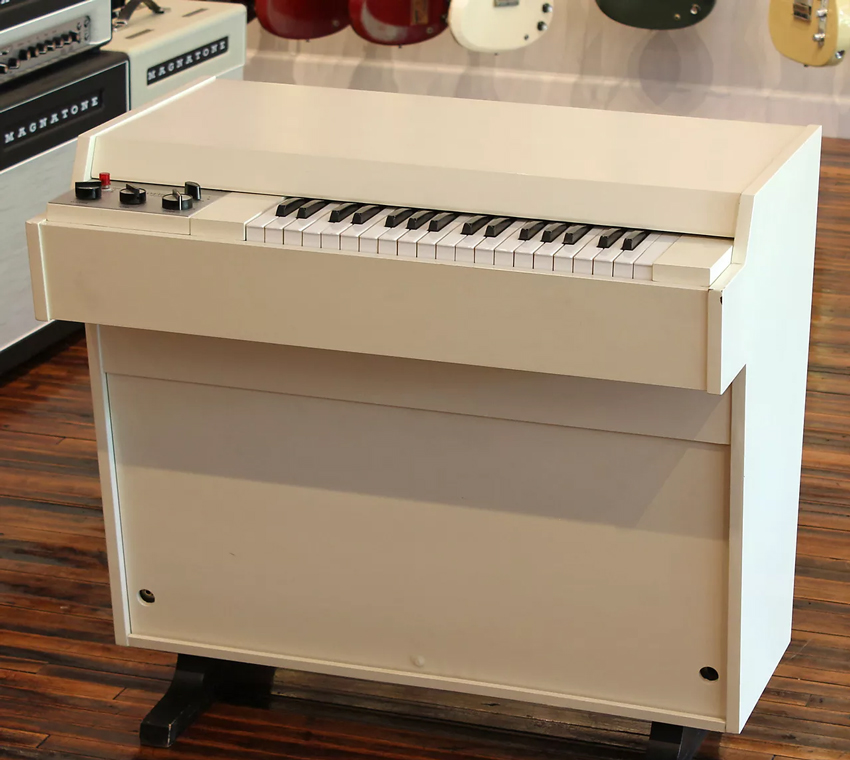November 1966, studio two at EMI's Abbey Road studios, and Paul McCartney is fiddling with a Mellotron Mk2. He's looking for an intro to a song The Beatles are developing. As he plays a key on the Mellotron, a small pinchwheel on the key's underside pushes against a motorized rotating rod inside, which starts a length of magnetic tape moving, and at the same time a pad on the key's base pushes the tape against its individual playback head.
Thanks to the buttons Paul has pushed on the bank of controls above the keys to select Station 1 Track A, out comes a sound something like a grainy flute. He tries an E chord with three keys—G-sharp, B, and E in the bass. Paul chuckles to himself at the atmosphere that's beginning to emerge from this weird instrument. It seems like he has the basis of the song's new intro.

It's often said today that the Mellotron was a kind of early sampler, and given Paul's experience at Abbey Road, it's not hard to see why. Getting something like the real sound of another instrument from a keyboard was unknown at the time. In fact, the Mellotron, a big, heavy, self-contained machine that could deliver pre-recorded backing rhythms, accompaniments, and lead sounds, was designed to be a sort of high-end entertainment system to rival the Hammond organ.
Harry C. Chamberlin first explored the instrumental potential of a tape playback system in the late '40s and started making his Chamberlin keyboards in California. In the early '60s, Harry's associate Bill Fransen found himself in England, apparently on the hunt for a supplier of playback heads. He fetched up at Bradmatic in Birmingham, a small firm run by three brothers—Leslie, Norman, and Frank Bradley—who, among other things, made tape recorders. Bill gave the Bradleys the impression that the tape-keyboard idea was his—an oversight that later led to a cash settlement with Harry Chamberlin—and soon they formed a company to produce the playback instrument. They decided to call it the Mellotron, the name a mashup of "melody electronics."
Eric Robinson, a successful British dance band leader, helped finance the new operation along with the celebrity magician David Nixon. (There's a wonderfully cheesy '60s Pathé news film with the pair showing off the instrument's home-entertainment possibilities.) Eric not only put in cash, but also he supervised recordings of the Mellotron master tapes at his IBC studios in London. The recordings the musicians made provided all the sounds required for the Mellotron's reproductions of brass, woodwind, strings, and more.
The first Mellotron was the Mk1 of 1963, more or less a copy of the Chamberlin, and it was short-lived. An improvement was the Mk2, introduced in 1964 at a mighty £1,000 list price (about $2,800 at the time, something like $22,000 in today's money) and the type hired in by Abbey Road and prodded by Paul.
It had two 35-note keyboards, G to F, side by side. The left one offered rhythms and phrases from the keys to the left, revealing its home-entertainment origins (Cuban, Viennese Waltz, Bolero, and so on), and to the right were keys for accompaniments such as Church Organ, Swinging Flutes, Blues Beat In F, and more. The right keyboard offered lead or melody instruments, including Paul's Flute as well as Tenor Sax, 3 Violins, Mandolin, and so on.
Each of the 70 keys of a Mk2 activated an individual length of magnetic tape, which explains why the Mk2 is sometimes described as 70 tape machines in a box. There were six different sounds or sets along the length of each tape, selectable as Stations, and three different sounds across the tape, selectable as Tracks, providing 18 sounds from each key.


The Mk2 had a built-in stereo amp and speakers, plus reverb and pitch among the controls. Everything was built into a large wooden case that resulted in a very heavy, Hammond-like piece of furniture. Definitely not a machine you'd want to take on the road.
In the studio, some rock and pop musicians began to discover the Mellotron's potential to create a particular atmosphere from its taped reproductions of real instruments. Crucially, they also grasped that its sounds were best considered as unique creations rather than faithful imitations.
Some of the Mellotron's peculiarities added to that uniqueness, including the several-generations quality of the tapes themselves, a distinct tendency to go out of tune, the limit on a note's length to eight or so seconds, and a distinct click often heard at the start of a note as the playback head was engaged. These factors and more made the Mellotron a timely arrival on a pop scene hungry for anything different and unusual. Early adopters included John Lennon, who in 1965 bought a Mk2 for his home music room after seeing it in action at IBC.

That same year, 1965, saw some of the earliest pop recordings featuring a Mellotron, made by The Graham Bond Organisation during a July session at Olympic studio in London. Several tracks on Graham's album There's A Bond Between Us featured some low-key Mellotron in addition to his regular Hammond, including "Baby Can It Be True" and the single "Lease On Love." More striking was the first hit with a Mellotron, Manfred Mann's 1966 single "Semi-Detached, Suburban Mr. James," recorded at Philips in London with a distinctive Mellotron flute intro.
Other Mellotron models followed the Mk2, including an effects-loaded version used by the BBC and others. In 1968, the single-manual, 52-key M300 appeared, and a few years later there was an improved version of this—the 35-key M400. The 400 was smaller than a Mk2, had simpler controls, no amp nor speaker, and a single set of tape sounds, coming as standard with switchable flute, violins, or cello, although custom sets could be fitted.
Not surprisingly, the white 400 was the one used on the road by a number of brave rock bands who in the '70s made the Mellotron a key ingredient of the prog recipe. The bands of this era included The Moody Blues, King Crimson, Yes, Tangerine Dream, Barclay James Harvest, and Genesis.
Digital sampling, a more efficient and reliable means of re-creating and modifying real instrument sounds, should have killed the Mellotron. And for a while, that seemed to be the case. Knotty business problems meant the British company lost the Mellotron name, although it continued to make the instruments as Novatrons until 1986, and Chamberlin had stopped making their versions around 1981.
But the eccentric sound of the Mellotron, a product of its decidedly analogue innards, proved to be resilient. David Kean and Markus Resch kept things going with early offerings of Mellotron and Chamberlin samples, and, as Mellotron Archives, made the MkVI (1999) and MkVII (2003) models, and worked on the preservation of the original tape library for both Mellotron and Chamberlin. The British operation was revived by John Bradley (son of co-founder Les Bradley) and Martin Smith, who in 1993 masterminded a Mellotron tribute CD, The Rime Of The Ancient Sampler. For some musicians, the attractions of the Mellotron had never gone away, but now there was something of a revival, with Radiohead, Oasis, and others featuring those unmistakable sounds.


These days, you can buy a new instrument from John and Martin at Streetly Electronics, the M4000, or you can seek out an original (and probably need to have it refurbished). You can also find the M4000D digital keyboard, M4000D Mini, or M4000D Rack unit, which lets you play Mellotron's digital collection of tape sounds on your MIDI keyboard of choice.
You can get an app for a few dollars, or you can check out one of several plugins offering generous swathes of Mellotronical sounds. It's never been easier to make a Mellotron noise.
Back in 1966, Paul McCartney persevered with the Mk2 in Abbey Road and put a lovely flute-like intro on the front of that new Beatles song, 'Strawberry Fields Forever.' It's survived for more than 50 years as the best Mellotron advertisement of all time.
Rick Wakeman played Mellotron on David Bowie's "Space Oddity" (and for his trouble was paid a session fee of £9, about $20 at the time) and later with Strawbs, Yes, and his own solo work. He summed up the balance between the charms and the idiosyncrasies of Mellotrons: "I love the unique sounds they produce," he told Frank Samagaio in The Mellotron Book. "But at the same time I've been reduced to tears when they frequently misbehaved whilst out on tour."
For now, though, I'll finish with my personal top 11 'Tron tracks, in no particular order. I dare say you'll be keen to remind us about the even better ones I've overlooked.
- 1. Julie Driscoll, Brian Auger & The Trinity - "This Wheel's On Fire"
- 2. King Crimson - "The Court Of The Crimson King"
- 3. The Beatles - "Flying"
- 4. Genesis - "Watcher Of The Skies"
- 5. The Moody Blues - "Nights In White Satin"
- 6. Orchestral Manoeuvres In The Dark - "Maid Of Orleans"
- 7. Radiohead - "Exit Music (For a Film)"
- 8. Simon Dupree & The Big Sound - "Kites"
- 9. Talk Talk - "Life's What You Make It"
- 10. The Zombies - "Hung Up On A Dream"
- 11. Pink Floyd - "Julia Dream"
Update: After reading Tony Bacon’s take, Streetly Electronics’ Martin Smith wanted to jump in with his favorite Mellotron tracks as well: "This article is nicely clear and concise... and accurate. Hurrah! I have to mention, being a pedant, that The Moodies never used the M400, but apart from that..." Here’s his Top 11:
- 1. Strawbs - "New World"
- 2. Radiohead - "Exit Music (For A Film)"
- 3. Führs & Fröhling - "Ammernoon"
- 4. Stackridge - "God Speed The Plough"
- 5. Jethro Tull - "The Witches Promise"
- 6. Barclay James Harvest - "Ursula (The Swansea Song)"
- 7. Premiata Forneria Marconi - "River Of Life"
- 8. Genesis - "Entangled"
- 9. The Moody Blues - "Out And In"
- 10. The Zombies - "Hung Up On A Dream"
- 11. King Crimson - "Starless"
About the Author: Tony Bacon writes about musical instruments, musicians, and music. He is a co-founder of Backbeat UK and Jawbone Press. His books include London Live and Electric Guitars: The Illustrated Encyclopedia, and he is the editor of the various editions of Beatles Gear. Tony lives in Bristol, England. More info at tonybacon.co.uk.
